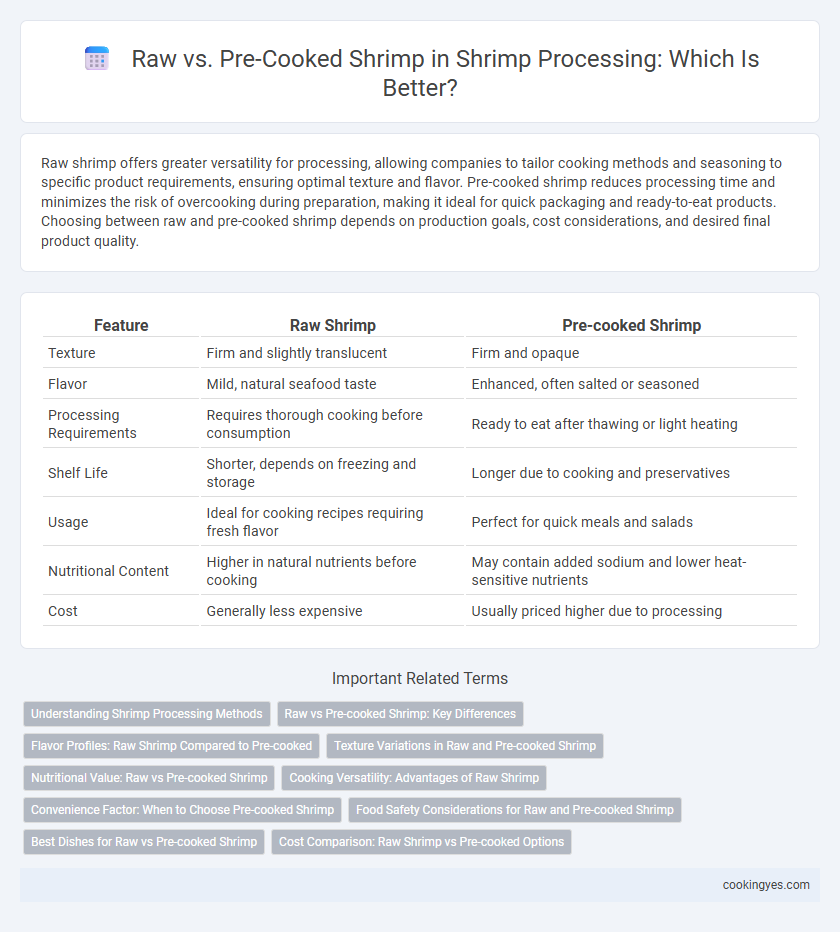Raw shrimp offers greater versatility for processing, allowing companies to tailor cooking methods and seasoning to specific product requirements, ensuring optimal texture and flavor. Pre-cooked shrimp reduces processing time and minimizes the risk of overcooking during preparation, making it ideal for quick packaging and ready-to-eat products. Choosing between raw and pre-cooked shrimp depends on production goals, cost considerations, and desired final product quality.
Table of Comparison
| Feature | Raw Shrimp | Pre-cooked Shrimp |
|---|---|---|
| Texture | Firm and slightly translucent | Firm and opaque |
| Flavor | Mild, natural seafood taste | Enhanced, often salted or seasoned |
| Processing Requirements | Requires thorough cooking before consumption | Ready to eat after thawing or light heating |
| Shelf Life | Shorter, depends on freezing and storage | Longer due to cooking and preservatives |
| Usage | Ideal for cooking recipes requiring fresh flavor | Perfect for quick meals and salads |
| Nutritional Content | Higher in natural nutrients before cooking | May contain added sodium and lower heat-sensitive nutrients |
| Cost | Generally less expensive | Usually priced higher due to processing |
Understanding Shrimp Processing Methods
Raw shrimp undergoes minimal processing, typically involving washing, peeling, and deveining before freezing or cooking, which preserves its natural texture and flavor. Pre-cooked shrimp is steamed or boiled then rapidly chilled, offering convenience but often altering the shrimp's firmness and taste profile. Selecting between raw and pre-cooked shrimp depends on the desired culinary application and shelf-life requirements, with processing methods directly impacting quality and consumer preference.
Raw vs Pre-cooked Shrimp: Key Differences
Raw shrimp contains natural enzymes and higher moisture content, which affect texture and shelf life during processing, while pre-cooked shrimp undergoes heat treatment that alters protein structure and extends storage duration. Raw shrimp processing requires careful handling to preserve freshness and prevent spoilage, whereas pre-cooked shrimp simplifies preparation and reduces cooking time for consumers. Color, flavor, and texture profiles differ significantly between raw and pre-cooked shrimp, influencing market preferences and culinary applications.
Flavor Profiles: Raw Shrimp Compared to Pre-cooked
Raw shrimp offer a sweeter and more delicate flavor profile, retaining the natural briny and oceanic notes that are often diminished during pre-cooking. Pre-cooked shrimp, while convenient, can develop a firmer texture and a slightly less nuanced taste due to the cooking process, which sometimes imparts a mild, cooked seafood flavor. Understanding these flavor distinctions is crucial for chefs and processors aiming to optimize shrimp dishes or products for quality and consumer preference.
Texture Variations in Raw and Pre-cooked Shrimp
Raw shrimp have a firm, translucent texture with a slightly springy bite, which softens during cooking and allows for precise texture control in processing. Pre-cooked shrimp, often steamed or boiled, exhibit a firmer, rubbery texture that can limit further manipulation in recipes or processing operations. Understanding these texture variations is critical for food manufacturers aiming to optimize product quality and customer satisfaction in shrimp-based offerings.
Nutritional Value: Raw vs Pre-cooked Shrimp
Raw shrimp retains higher levels of essential nutrients such as omega-3 fatty acids and B vitamins compared to pre-cooked varieties, which often experience nutrient degradation during cooking processes. Pre-cooked shrimp may lose water-soluble vitamins and some antioxidants due to heat exposure and processing methods. Studies indicate that consuming raw shrimp, properly handled for safety, maximizes intake of critical nutrients vital for cardiovascular and cognitive health.
Cooking Versatility: Advantages of Raw Shrimp
Raw shrimp offers superior cooking versatility compared to pre-cooked shrimp, allowing chefs to control texture and flavor through various methods such as boiling, grilling, or sauteing. Its uncooked state ensures maximum absorption of marinades and spices, enhancing the final taste profile in diverse culinary applications. Using raw shrimp in processing also reduces the risk of overcooking, which can result in rubbery or tough texture commonly seen with pre-cooked shrimp.
Convenience Factor: When to Choose Pre-cooked Shrimp
Pre-cooked shrimp offers significant convenience by eliminating the need for extensive cooking, making it ideal for quick meals, salads, and snacks. It reduces preparation time and minimizes the risk of overcooking, ensuring consistent texture and flavor. Pre-cooked shrimp is the preferred choice in fast-paced foodservice environments and ready-to-eat product formulations.
Food Safety Considerations for Raw and Pre-cooked Shrimp
Raw shrimp require stringent temperature control and immediate refrigeration to prevent bacterial growth and contamination by pathogens like Vibrio and Salmonella. Pre-cooked shrimp undergo heat treatment to eliminate most harmful microorganisms, but they remain susceptible to post-processing contamination and must be stored at appropriate temperatures to maintain safety. Both raw and pre-cooked shrimp processing demand adherence to Hazard Analysis Critical Control Point (HACCP) protocols to ensure food safety and minimize risks of foodborne illnesses.
Best Dishes for Raw vs Pre-cooked Shrimp
Raw shrimp is ideal for dishes like ceviche, shrimp tartare, and sushi, where freshness and texture are paramount. Pre-cooked shrimp suits recipes such as shrimp cocktails, salads, and stir-fries, providing convenience and consistent taste. Choosing raw or pre-cooked shrimp depends on dish preparation time, desired flavor intensity, and culinary style.
Cost Comparison: Raw Shrimp vs Pre-cooked Options
Raw shrimp generally offer lower upfront costs compared to pre-cooked shrimp due to minimal processing requirements, making them more economical for large-scale operations. Pre-cooked shrimp incur higher expenses linked to cooking, cooling, and packaging processes, increasing overall cost per pound. However, pre-cooked shrimp can reduce labor and preparation time in downstream applications, potentially offsetting the initial higher price with operational savings.
Raw vs Pre-cooked for shrimp processing Infographic

 cookingyes.com
cookingyes.com